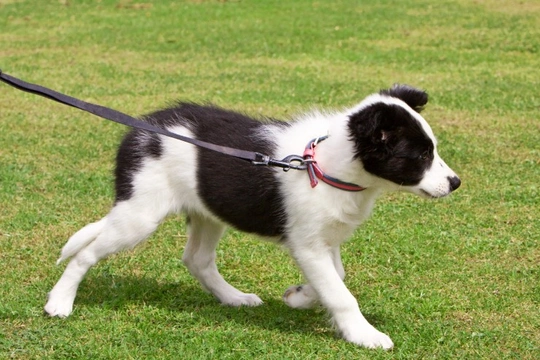
Teaching your dog which side of you to walk on whilst on the lead
Learning to walk nicely on the lead is a skill that dog owners should begin teaching their pups virtually as soon as you bring them home, and how you handle the puppy’s first few walks and experiences on the lead will set the tone for the remainder of their life.
It is much easier to avoid and correct problems in the puppy as soon as they arise than it is in the adult dog later on – and many dogs that pull on the lead as adults can be very hard to retrain from doing so, when this behaviour would likely have only taken a couple of gentle corrections in the puppy when they were first starting out.
Pulling on the lead, chewing the lead or failing to walk to heel are all common problems faced when training puppies, and that often manifest in adult dogs too as learned behaviours. However, another skill you can teach your dog when you begin introducing them to the lead is to remain on one side of you for walks rather than the other, and not to swap and change from side to side, getting underfoot when they do so.
Most of us have a preferred side for our dog to walk on – much as most of us have a preferred hand or shoulder we’ll hold a bag in or on – and it can feel odd or not quite right if things are reversed to the other hand. Teaching a dog to walk on what you choose as the “correct” side whilst on the lead shouldn’t be complicated, but it is a skill that a lot of dog owners overlook when teaching pups to walk to heel.
In this article we will explain how to teach your dog which side of you to walk on and avoid them criss-crossing in front of you, and why this is useful. Read on to learn more.
Which side is best?
If you find that when walking dogs you naturally prefer to keep them on one side of you rather than the other, this is probably the “best” side for you and your own dog. If you don’t have a real preference, think about which is your dominant hand, and whether or not you prefer to use that hand to hold the lead, or to keep it free.
If you intend to enter your dog in dog shows when they get older, they will need to be able to walk to heel reliably in both directions, as they will be expected to do in the show ring, so that the judges see your dog and not you in the centre. This may mean that you will also need to teach the dog a command to switch over, but this is something to look at further down the line.
A good way to pick the best side to walk your dog on if you’re not sure or have no preference (or even if you do!) is to keep yourself between your dog and the passing traffic when walking on the road, which usually means having your dog walk on your left, as long as you switch the side of the road you are walking on when you change direction.
How to teach your dog which side of you to walk on
To begin teaching a dog any new skill, you should use a relatively short lead rather than an extending one, as this provides better control. If you’re training a new pup for the first time, take some time to see if they naturally gravitate to one side or follow your instinctive direction on your preferred side, and it might just be as simple as that!
However, if your dog keeps criss-crossing in front of you, switching from side to side, or seems to favour the side you don’t want them to be on, you will need to be rather more proactive.
As for most skills that involve teaching your dog something new, you’re going to need treats – and lots of them! First up, keep the treats in the pocket on the side you want your dog to walk on. This will keep them from criss-crossing to get closer to their reward!
By keeping the treats on the dog’s side, you will also free up your other hand (the one not holding the lead) to reach for those treats, without compromising your grip on the lead.
If your dog is criss-crossing, stop them, call them to heel (on the side you prefer) ask them to sit, then give a treat. Begin moving again when your dog complies. Make sure that you do not give your dog the treat until they are facing forwards on your desired side – if they are still in motion, wait, and ensure that you give the treat when your dog is beside you and not still in front of you.
When your dog does start wandering to the other side or cutting in front of you, stop, call the dog back to the desired side, wait for them to face forwards, and give another treat. Use the lead to gently check your dog and keep them from wandering too far the wrong way, but if you need to move your dog back from in front of you or from the wrong side, ensure that they have completed the move and are in the right position to continue before you pay out with that treat.
Holding a favourite toy in the lead hand or letting your dog know it is in a pocket on your preferred side can help too – if your dog associates that side’s pocket or hand as the one that holds the goodies, they will begin to gravitate to that side all on their own with enough repetition.



